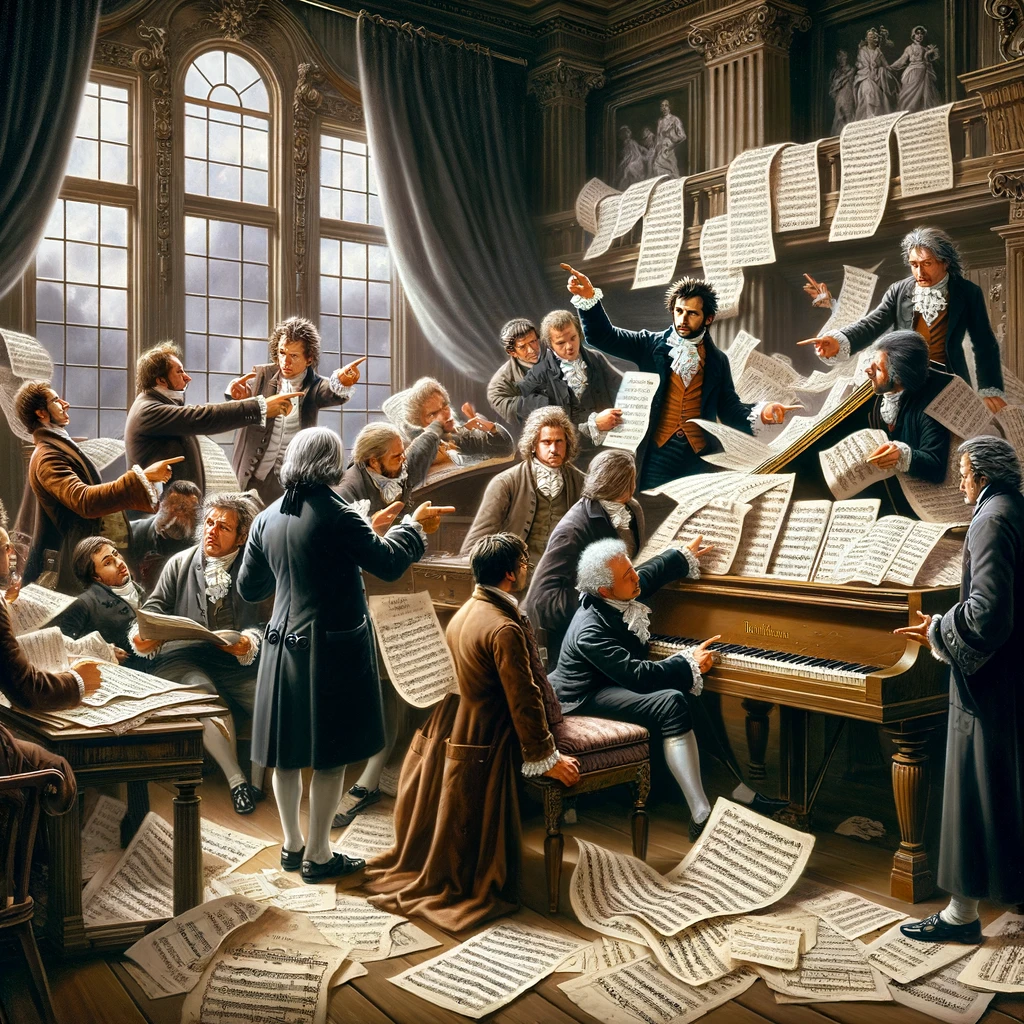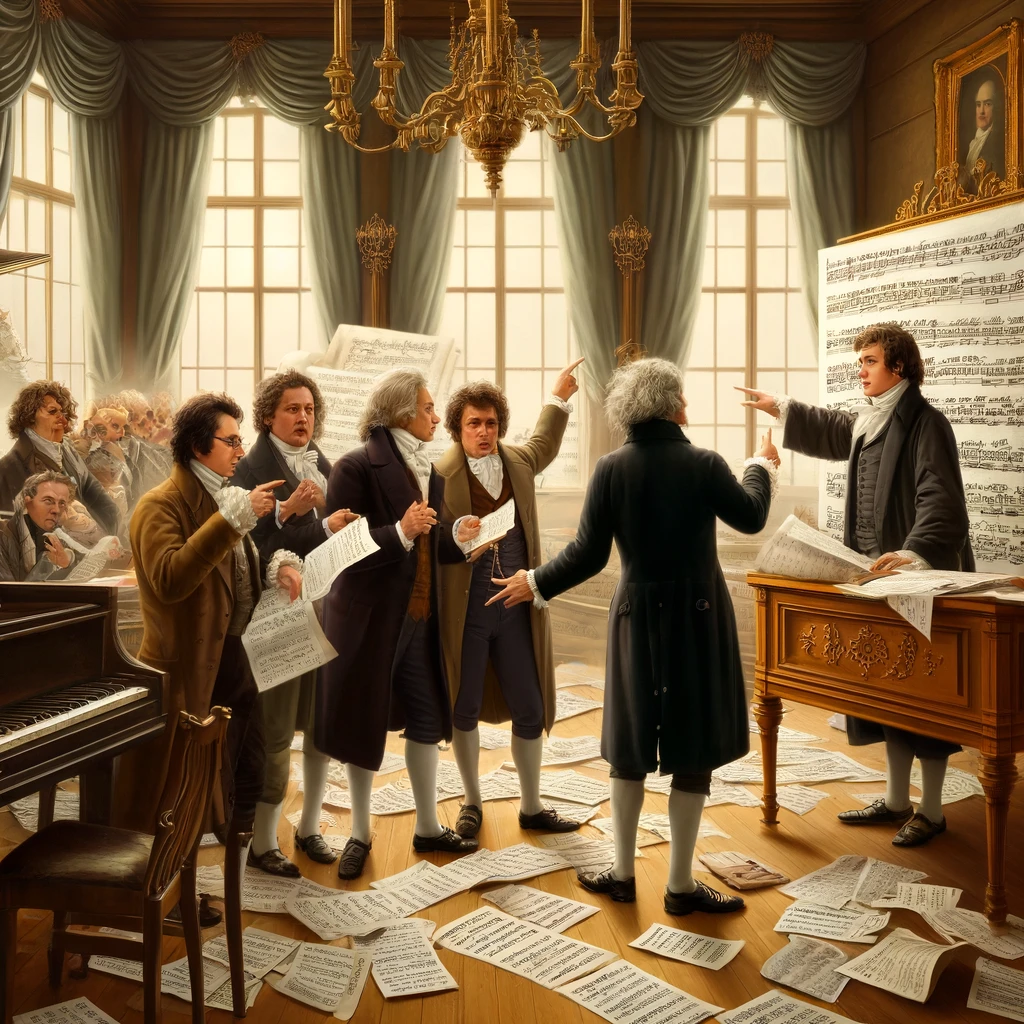
Beethoven’s Controversies: Revisions and Editions
Ludwig van Beethoven, a towering figure in classical music, is often remembered for his groundbreaking symphonies and sonatas. Yet, beyond these monumental achievements lies a fascinating layer of complexity regarding his creative process. Beethoven’s approach to composing was dynamic and iterative, often revising his music extensively, which led to the existence of multiple editions of the same work. These revisions and the proliferation of varying editions have sparked significant debate among musicians, scholars, and enthusiasts.
The Nature of Beethoven’s Revisions
Beethoven’s revisions were not mere tweaks but sometimes comprehensive transformations that could alter entire sections of his compositions. His meticulous and somewhat perfectionist approach was driven by a relentless pursuit of artistic truth and expression. For instance, the famous Symphony No. 5 underwent several revisions before reaching the form we know today. Early drafts and sketches show Beethoven experimenting with different melodies and rhythms, indicating his deep commitment to achieving a particular musical impact.
Motivations Behind the Revisions
What compelled Beethoven to revise his works so thoroughly? Multiple factors influenced his revisions. First, Beethoven was known for his acute self-criticism. He often returned to his compositions with a fresh perspective, identifying areas he believed needed improvement. Second, external feedback played a role. After performances, he would sometimes modify sections of his works based on the audience’s reaction or the advice of trusted colleagues.
Impact of Hearing Loss
Beethoven’s deteriorating hearing is another crucial aspect of this narrative. As his condition worsened, he became more introspective and reliant on his inner musical ear. This shift sometimes led him to revise earlier works that he felt could better reflect his evolving musical vision, even as he struggled with the isolation his deafness imposed.
The Challenge of Multiple Editions
The existence of multiple editions of Beethoven’s works presents a unique challenge. Different versions can vary substantially, with alterations in phrasing, dynamics, and even notes. This variability poses dilemmas for performers and conductors: Which version is the most authentic? Which reflects Beethoven’s true intentions?
Take the case of Piano Sonata No. 28, Op. 101. Various editions offer differing interpretations of the dynamics and articulations, leading to distinct performance outcomes. This situation often forces musicians to act as detectives, piecing together clues from various sources to ascertain the composer’s intentions.
Editions and Editor Influence
The role of editors and publishers has also been significant in shaping the versions of Beethoven’s works available today. During Beethoven’s lifetime and posthumously, editors took considerable liberties in interpreting his manuscripts. Sometimes, these interpretations were based on solid knowledge and genuine insights into Beethoven’s intentions; other times, they were merely speculative.
Scholarly Work and Modern Reconstructions
In recent decades, musicologists have embarked on rigorous projects to produce more definitive editions of Beethoven’s works. These efforts involve painstaking comparisons of existing manuscripts, original sketches, and first editions, often annotated by Beethoven himself. The goal is to reconcile differences and present versions of the works that are as close as possible to what Beethoven intended.
The Ethical Dimensions of Revising Beethoven
The ethical dimensions of revising and interpreting Beethoven’s music are complex. Some purists argue that performing only the versions that Beethoven last approved respects his artistic vision. Others contend that earlier versions of his works, which might be more experimental or reveal a different aspect of his creative process, are equally valid and deserving of performance.
Beethoven’s Legacy and Performer Freedom
Ultimately, Beethoven’s legacy is enriched, not diminished, by the controversies over his revisions and the multiple editions of his works. These discussions emphasize the evolving nature of musical interpretation and the active role performers play in bringing music to life. Each performance of a Beethoven piece can be seen as a new interpretation, a fresh chance to engage with the composer’s rich musical language.
The controversies surrounding Beethoven’s music revisions and the multiple editions of his works highlight a dynamic, ever-evolving relationship between the composer, his music, and its interpreters. This ongoing dialogue ensures that Beethoven’s legacy continues to inspire and challenge, resonating with new generations of musicians and music lovers.

The Role of Technology in Unraveling Beethoven’s Revisions
In the digital age, technology plays a pivotal role in unraveling the complexities of Beethoven’s multiple editions and revisions. Advanced imaging techniques and digital archiving have allowed scholars to access and analyze manuscripts that were previously too fragile or rare to study extensively. These technological tools help to decode Beethoven’s handwriting, which was notoriously difficult to decipher, especially in his later years when his health was declining.
Moreover, software designed to compare different versions of musical scores can highlight even minor changes that might not be immediately obvious to the human eye. These changes often provide critical insights into Beethoven’s thought process and how his ideas evolved over time. The digital reconstructions of his works not only offer more accurate editions but also democratize access to these historical documents, allowing musicians around the world to explore various facets of his music with greater ease.
Performance Practices and Artistic Interpretation
The availability of multiple editions has also significantly influenced performance practices. Musicians today have the liberty to choose from a spectrum of Beethoven’s works, ranging from his initial drafts to his final revisions. This choice grants performers a certain artistic freedom, enabling them to interpret Beethoven’s music in ways that can be both personal and historically informed.
For instance, some pianists prefer to perform early versions of his sonatas, appreciating the raw emotion and boldness in these compositions. Others opt for the later, more polished editions, valuing the refinement and depth Beethoven brought to his revised scores. This selection process has led to a rich diversity of performances, each offering a unique perspective on Beethoven’s artistic legacy.
Debates Among Historians and Musicians
The debates among historians, musicologists, and performers about which editions best represent Beethoven’s true intentions are vigorous and ongoing. These discussions often extend beyond academic circles to public seminars and symposiums, engaging a broader audience. They not only enhance our understanding of Beethoven’s works but also raise broader questions about authenticity, preservation, and evolution in music.
For example, the debate over the Hammerklavier Sonata involves significant discrepancies in tempo markings between different editions. Some scholars argue that the extremely fast tempo indicated in one edition might have been a metronome error by Beethoven, while others believe it was an intentional choice that challenges performers to push the boundaries of their technical abilities.
Cultural Impact and Public Perception
The controversies and complexities surrounding Beethoven’s revisions and the various editions of his works also impact how the public perceives classical music. They highlight the dynamic and unfinished nature of artistic creation, presenting classical music as a living tradition that continuously evolves and adapts over time. This perspective can make classical music more accessible and relevant to contemporary audiences, who may find the idea of engaging with an artist’s creative process particularly fascinating.
Conclusion: Embracing the Complexity
Embracing the complexity of Beethoven’s revisions and the existence of multiple editions does not undermine his genius but rather illuminates the depth of his creative spirit and the enduring relevance of his music. As we continue to explore and debate his works, we not only preserve his legacy but also enrich our own cultural experience and understanding of music.
Beethoven’s story is a testament to the fact that music is not static but a vibrant form of art that speaks across generations, continually reinvented through new interpretations and insights. As such, the controversies surrounding his revisions and editions are not mere scholarly disputes but gateways to deeper engagement with the art of music itself.
References
- Cooper, Barry. “Beethoven and the Creative Process.” Oxford University Press, 1990.
- Kinderman, William. “Beethoven’s Compositional Process.” University of Nebraska Press, 1991.
- Solomon, Maynard. “Beethoven Essays.” Harvard University Press, 1988.
- Swafford, Jan. “Beethoven: Anguish and Triumph.” Houghton Mifflin Harcourt, 2014.